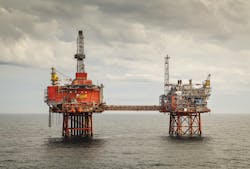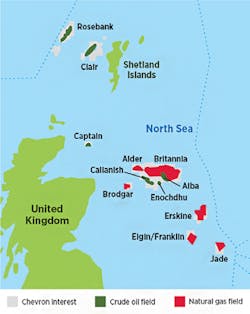Jeremy Beckman
Editor, Europe
The Captain production complex in the UK central North Sea. (Images courtesy Chevron)
Late last year, Chevron committed to the application of polymer technology to enhance oil recovery from the Captain field in the UK central North Sea. The first-phase program, which follows various enhanced oil recovery (EOR) pilot trials at the field since 2010, is an expansion within the existing platform area, with five long-reach horizontal polymer injection wells planned.
Captain, discovered in 1977 in block 13/22a close to the Outer Moray Firth off northeast Scotland, is a billion-barrel field which began producing in March 1997. The production facilities comprise a wellhead protector platform and a bridge-linked platform connected to an FPSO vessel. The complexity of the reservoir and the relatively heavy crude have over the years necessitated extensive horizontal drilling, waterflood, and installation of downhole electric submersible pumps.
Britain’s Oil & Gas Authority (OGA) is keen to promote wider use of polymer technology in the wider North Sea area, as part of its remit to maximize the UK’s remaining offshore oil and gas resources. Chevron was one of the leading contributors to the OGA’s recently published document,Polymer Enhanced Oil Recovery – Industry Lessons Learned.
Colin Freeland, Captain EOR Project Manager at Chevron, explained the background to the project and the goals for the stage 1 program.
Offshore: For the phase 1 Captain EOR project, Chevron is applying a synthetic HPAM (partly hydrolyzed polyacrymalide) polymer. What are the beneficial properties of this polymer, and has it been used successfully on other heavy-oil field projects?
Freeland: Polymer is introduced to the injection water stream to increase the viscosity of the injected fluids. By doing this, the mobility ratio between the Captain oil and the injected fluid is reduced, leading to higher recovery. Other heavy-oil fields have used similar technology, however, this is the first major deployment of its type in the North Sea.
Offshore: Has it had to be adapted in any way to suit Captain’s needs?
Freeland: The polymer is procured as a liquid emulsion rather than a powder for offshore use and to enable this Chevron has entered into collaborations with polymer vendors to optimize their products for use in Captain. This collaboration has delivered a significant improvement over industry standard HPAM emulsions and we are now able to deploy the polymer with single stage mixing which is a more simple and cost effective method.
Offshore: What trials did the company run on this or alternative polymer formulations before committing to its use at Captain?
Freeland: Chevron runs a series of laboratory tests and yard trials before determining whether a polymer would be suitable for the Captain field.
Offshore: What is the extent of the current waterflood operation on the field, and will this continue, or be scaled back?
Freeland: The Captain field is under full waterflood development. For stage 1 of the Captain EOR project, the plan is to start up five polymer injection wells between 2017 and 2021. All other areas of the field will continue under waterflood and are subject to potential future EOR expansion.
Offshore: How many Chevron personnel are working on this project, both in Aberdeen and elsewhere, and which other companies are involved?
Freeland: There are 25 Chevron personnel working on the project team currently. We also rely on assistance from other company resources including Captain asset personnel, support staff in Chevron’s Upstream Europe Business Unit and Chevron Energy Technology Co. lab personnel. For stage 1, WorleyParsons is performing the facilities E&P workscopes; Petrofac is carrying out the offshore facilities installation work; Baker Hughes is supporting the logistics of the polymer supply chain (including QA/QC requirements); Honeywell is responsible for control system changes for each injection well that comes online; and Archer is supporting our drilling program. Wood is supporting some subsea screening work as we plan for stage 2 of the project.
Captain is in the Outer Moray Firth offshore northeast Scotland.
Offshore: In late 2014, the company planned to add a third platform specifically for polymer storage/injection. Was this scheme shelved purely because of the oil price fall, or did the company simply decide that a phased approach to polymer injection would be more practical?
Freeland: The project originally entered front-end engineering and design in 2014 as a full-field greenfield development. In 2016 to develop the field at a pace aligned with the information gained on polymer performance and to optimize the economics of the development the project was split into two phases. This has enabled Chevron to accelerate polymer injection as stage 1 uses existing wells in combination with newly drilled platform wells and some brownfield facilities upgrades. It will also allow Chevron to fully learn the lessons of operating a polymer flood prior to authorizing stage 2 (which is anticipated to be a higher capex development).
Offshore: Has drilling of the injector wells started, and when will the program be completed?
Freeland: As part of the stage 1 scope, we have appropriated funds to drill six wells – five producers and one injector. Two polymer injection wells were already onstream in 4Q 2017 classed as pilot wells. The stage 1 scope is to have four more polymer injection wells coming on in a phased program between July 2018 and 2021. One of the pilot wells will continue to inject polymer during this period also.
Offshore: Where will these wells be placed in relation to the existing producers, and are you expecting the benefits to be instant, or very gradual?
Freeland: The majority of wells required for stage 1 of the project already exist; the six new wells will be drilled between 2018 and 2023 and will be optimally placed to most effectively polymer flood the stage 1 development area.
Offshore: Is there the capability to vary injection rates per well, depending on the performance of the impacted production wells?
Freeland: Both injection and production well rates will be adjusted based on sound reservoir management principles.
Offshore: What are the various brownfield modifications needed for this project?
Freeland: We are using in-line mixing equipment which minimizes the spatial impact of the new mixing facilities. As such, the brownfield modifications are limited to polymer pumping facilities and some new/re-routed piping runs. Existing polymer storage on the Captain facilities is used with some small modifications required to accommodate the expansion for stage 1 of the project.
Offshore: Does the polymer have any impact on the produced oil, necessitating new process equipment?
Freeland: No new process equipment is required. However, some steps will need to be taken to minimize the impact of polymer returns on the Captain process.
Offshore: Are the equipment and the storage capacity sized to fit the first-phase wells only, or for the eventual expansion of polymer injection?
Freeland: The polymer storage capacity and equipment was installed in 1997 as part of the original Captain development plan and is sufficient for stage 1 with some minor modifications. Requirement for additional storage capacity will depend on the scope and timing of potential future EOR expansion.
Offshore: Has the Phase 1 program benefited in any way from Chevron’s collaboration with other North Sea area operators and the OGA’s polymer program?
Freeland: Chevron has taken a leading role in the OGA’s Polymer Forum and in the development of the industry lessons learned document. Chevron has also collaborated with other forum members on many polymer lessons learned and best practices.
Offshore: What is Chevron’s contribution to these programs?
Freeland: The importance of encouraging industry uptake of EOR was outlined in the Wood Maximising Recovery Review and is an integral theme of the Maximising Economic Recovery (MER) UK Asset Stewardship Board. The EOR Joint Industry Task Group was formed in late 2016 and comprised representatives from Chevron, Shell, BP and Statoil, all of which are currently developing Polymer EOR projects on the UK continental shelf.
The Polymer EOR Starter Pack is intended to support MER and future Polymer EOR projects. The aim of the pack is to help those considering future Polymer EOR projects to move forward by learning from existing Polymer EOR projects and understand the value from Polymer EOR for their own assets. Chevron played a key role in sharing its own learnings to help improve the framing, business case, and execution of EOR. In addition, citing its experience from Captain, a road map to Polymer EOR implementation was produced which represents a generally accepted view of the multiple stages that a successful EOR project should go through to mature from screening to implementation.
Offshore: The OGA’s recent Polymer report mentions the need for contingency plans to deal with the risks of injectivity loss or shear degradation – what would cause this to arise, and what are the planned mitigation measures for Captain?
Freeland: Chevron has worked hard in collaboration with polymer suppliers to design chemicals that do not cause injectivity loss. Our facilities team has designed the polymer distribution system such that any shear degradation issues have been mitigated.
Offshore: If Phase 1 is a success, what are the plans for expanding the scope of polymer EOR at Captain?
Freeland: Stage 2 represents the expansion to our subsea wells at Captain and will benefit from the learnings and experience we gain during stage 1 of the project.





